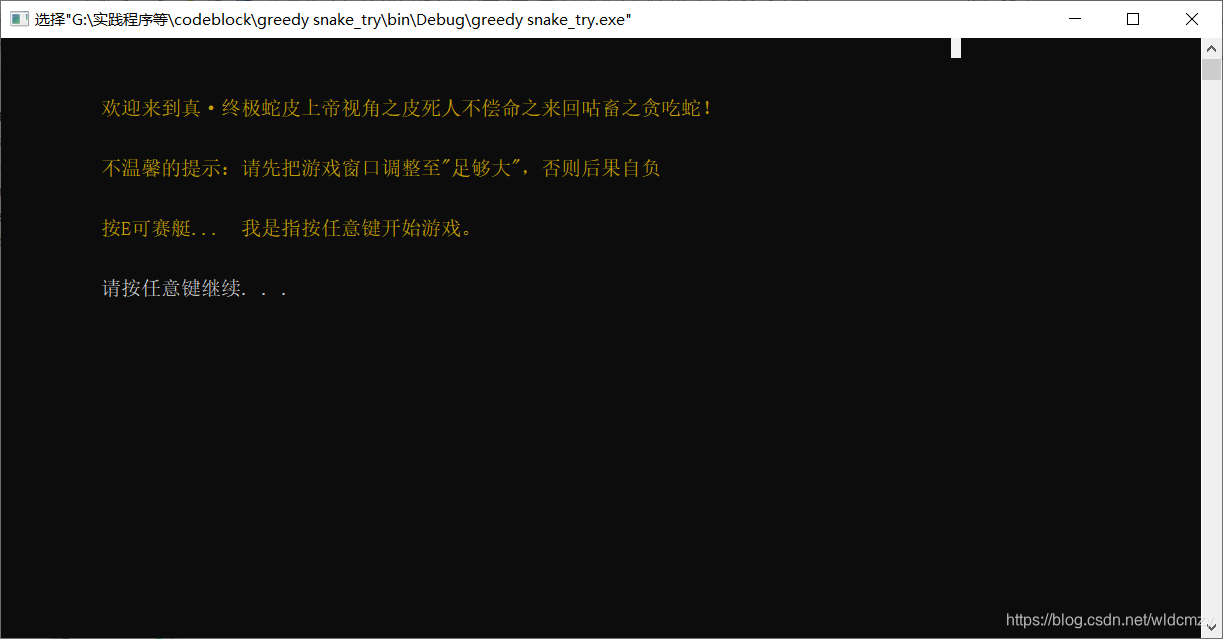说明 - 2022-05-05
本篇博客为本人原创, 原发布于CSDN, 在搭建个人博客后使用爬虫批量爬取并挂到个人博客, 出于一些技术原因博客未能完全还原到初始版本(而且我懒得修改), 在观看体验上会有一些瑕疵 ,若有需求会发布重制版总结性新博客。发布时间统一定为1111年11月11日。钦此。
刚开始查阅资料看别人的贪吃蛇代码,看得一头雾水,比如:
SetConsoleTextAttribute(GetStdHandle(STD_OUTPUT_HANDLE), c);
这是个什么玩意儿?
于是只能先去查阅一些资料。
1.技术支持
在稍微了解了控制台API函数后,发现这一堆巨长的字母也就是这么回事,虽然没背过,但拿过来用还是可以的。
移动光标的函数
个人感觉这个算比较重要的
void Gotoxy(int x, int y)
{
COORD position = { y, x };
SetConsoleCursorPosition(GetStdHandle(STD_OUTPUT_HANDLE), position);
}
更改字体颜色的函数
这个可以不要,纯粹是为了好看
int color(int c)
{
//SetConsoleTextAttribute是API设置控制台窗口字体颜色和背景色的函数
SetConsoleTextAttribute(GetStdHandle(STD_OUTPUT_HANDLE), c);
return 0;
}
隐藏光标的函数
在制作的过程中发现光标一闪一闪的很碍眼,最初的操作是在不需要在地图上打印东西时把光标移动到(0,0),但发现有时候光标还是会在地图内闪烁,于是加入了这个函数(这里对我来说有一个问题,会在“遗留问题部分说明”)
void cursor_visible(int size,int visible)
{
CONSOLE_CURSOR_INFO cursor_info;
cursor_info.bVisible=visible;
cursor_info.dwSize=size;
SetConsoleCursorInfo(GetStdHandle(STD_OUTPUT_HANDLE), &cursor_info);
}
其他
笔者自己的理解:
fflush(stdin);清空缓冲区
system(“cls”);刷屏
_kbhit() 相应键盘输入
getch() 接收字符
2.前期设定
设置一些基本的要素,如一些宏定义,全局变量,蛇与食物的结构体,函数声明,下面的代码中有一些时一开始就写上的,有一些是边写边加的(做完之后发现相较于最初的设想,改了好多东西)。
我把它们写在了自己的头文件head.h里:
#ifndef HEAD_H_INCLUDED
#define HEAD_H_INCLUDED
#define TALL 30//地图高度
#define DBW 68//地图宽度
#define SNAKE_MAXLEN 500//蛇的极限长度(用于定义数组)
#define SNAKE_INI_LEN 4
#define SNAKE_INI_DELAY 200
void cursor_visible(int,int);
int color(int);
void Gotoxy(int,int);
void welcome(void);
void printboard(void);
void printnotes(void);
void printsnake(void);
void printfood(void);
void snakemove(void);
int jgameover(void);
void gameover(int);
int jeat(void);
void repr_info(void);
int score;
struct
{
int x[SNAKE_MAXLEN];
int y[SNAKE_MAXLEN];
int delay;
int len;//目前蛇的长度
int dire;//direction蛇的移动方向
}snake;
struct
{
int x;
int y;
}food;
#endif // HEAD_H_INCLUDED
看别人写的贪吃蛇都没有用数组来记录蛇的位置,(猜)可能是因为数组会占用连续的空间,这样不太好。
(2020.04.15更新:他们都用的链表,当时我都没听过这东西)
3.着手实现
显示最初界面的函数
void welcome(void)
{
color(6);
Gotoxy(3,10);
printf(“欢迎来到真·终极蛇皮上帝视角之皮死人不偿命之来回咕畜之贪吃蛇!”);
Gotoxy(6,10);
printf(“不温馨的提示:请先把游戏窗口调整至"足够大”,否则后果自负");
Gotoxy(9,10);
printf(“按E可赛艇… 我是指按任意键开始游戏。”);
Gotoxy(12,10);
color(7);
system(“pause”);
}
效果图

画地图
发现代码写得好粗啊,浪费资源
void printboard(void)
{
int i,j;
system(“cls”);
color(9);
for(i=0;i<=TALL;i++)
for(j=0;j<=DBW;j+=2)
if(i0||iTALL||j0||jDBW)
{
Gotoxy(i,j);
printf(“■”);
}
color(7);
}
显示地图之外的一些信息
void printnotes(void)
{
color(2);
Gotoxy(3,74);
printf(“当前得分:%d”,score);
Gotoxy(4,74);
printf(“当前蛇长:%d节”,SNAKE_INI_LEN);
Gotoxy(8,74);
printf(“当前难度:较为平和”);
Gotoxy(9,74);
printf(“等待延迟:%d ms(最小为20ms)”,SNAKE_INI_DELAY);
//Gotoxy(12,74);
//printf(“历史最高分为:”);
color(7);
}
画静态蛇
void printsnake(void)
{
snake.x[0]=TALL/2;
snake.y[0]=DBW/2;
snake.delay=SNAKE_INI_DELAY;
snake.len=SNAKE_INI_LEN;
snake.dire=‘w’;
Gotoxy(snake.x[0],snake.y[0]);
printf(“⊙”);
for(int i=1;i<4;i++)
{
snake.x[i]=snake.x[i-1];
snake.y[i]=snake.y[i-1]+2;
Gotoxy(snake.x[i],snake.y[i]);
printf(“■”);
}
随机生成食物
要通过一些措施保证食物在地图之内,而且还不能出现在蛇的身上。(这里也存在一个问题,会在之后的“遗留问题”部分说明。)
需要注意一个细节,‘■’会横向占用两个字节,所以要让它们统一在偶数坐标生成
void printfood(void)
{
food.x=rand()%(TALL-2)+1;
food.y=rand()%(DBW-4)+2;
if(food.y%2)
food.y++;
int notput=1;
while(notput)
{
for(int i=0;i<snake.len;i++)
{
if(!(food.xsnake.x[i]&&food.ysnake.y[i]))
{
Gotoxy(food.x,food.y);
printf(“奥”);
notput=0;
break;
}
}
}
}
蛇的移动
思路是先记录蛇最后一节的位置,用“
”(两个空格)覆盖蛇尾,在蛇的移动方向的下一个位置画蛇头,如果蛇吃到了食物,则在擦去的地方给蛇补充一节,一些相应的信息也要作改变
查阅资料得到了_kbhit()和getch()的用法,_kbhit()可以响应键盘输入(大概),getch()可以接收字符,由于作者的了解也不深入,所以不多说。
PS:隐藏光标的操作是后来加上的,导致某些移动光标的操作纯属多余
void snakemove(void)
{
int lastx=snake.x[snake.len-1],lasty=snake.y[snake.len-1];
if(_kbhit())
{
fflush(stdin);
snake.dire=getch();
}
for(int i=snake.len-1;i>0;i–)
{
snake.x[i]=snake.x[i-1];
snake.y[i]=snake.y[i-1];
}
switch(snake.dire)
{
case ‘w’:
case ‘W’:
snake.x[0]-=1;
break;
case ‘S’:
case ‘s’:
snake.x[0]+=1;
break;
case ‘A’:
case ‘a’:
snake.y[0]-=2;
break;
case ‘D’:
case ‘d’:
snake.y[0]+=2;
break;
}
Gotoxy(snake.x[1],snake.y[1]);
printf(“■”);
Gotoxy(snake.x[0],snake.y[0]);
printf(“⊙”);
if(jeat())
{
score++;
if(snake.len<SNAKE_MAXLEN)
snake.len++;
if(snake.delay>=22)
snake.delay-=2;
snake.x[snake.len-1]=lastx;
snake.y[snake.len-1]=lasty;
printfood();
repr_info();
}
else
{
Gotoxy(lastx,lasty);
printf(" ");
}
Gotoxy(0,0);
}
在蛇吃到食物后,改变一些显示信息
reprint information
void repr_info(void)
{
Gotoxy(3,84);
color(2);
printf("%d",score);
Gotoxy(4,84);
printf("%d",snake.len);
Gotoxy(8,84);
if(snake.delay>=170)
printf(“较为平和”);
else if(snake.delay>=120)
printf(“略高一筹”);
else if(snake.delay>=90)
printf(“考验手速”);
else if(snake.delay>=50)
printf(“高能预警”);
else if(snake.delay>=22)
printf(“终极蛇皮”);
else
printf("MAX “);
Gotoxy(9,84);
printf(”%d ",snake.delay);
color(7);
}
检验是否吃到食物
judge eat
int jeat(void)
{
if(food.xsnake.x[0]&&food.ysnake.y[0])
return 1;
return 0;
}
检验蛇是否死亡
int jgameover(void)
{
if(snake.x[0]==TALL||snake.x[0]==0||snake.y[0]==0||snake.y[0]==DBW)
return 1;
for(int i=1;i<snake.len;i++)
{
if(snake.x[0]==snake.x[i]&&snake.y[0]==snake.y[i])
return 2;
}
return 0;
}
打印死亡后显示的一些东西
void gameover(int j)
{
Gotoxy(20,75);
printf(“Game over\n”);
Gotoxy(21,73);
if(j1)
printf(“死因:铁齿铜牙与头铁”);
else if(j2)
printf(“死因:我吃我自己”);
}
以下是所有代码
头文件
#ifndef HEAD_H_INCLUDED
#define HEAD_H_INCLUDED
#define TALL 30//地图高度
#define DBW 68//地图宽度
#define SNAKE_MAXLEN 500//蛇的极限长度(用于定义数组)
#define SNAKE_INI_LEN 4
#define SNAKE_INI_DELAY 200
void cursor_visible(int,int);
int color(int);
void Gotoxy(int,int);
void welcome(void);
void printboard(void);
void printnotes(void);
void printsnake(void);
void printfood(void);
void snakemove(void);
int jgameover(void);
void gameover(int);
int jeat(void);
void repr_info(void);
int score;
struct
{
int x[SNAKE_MAXLEN];
int y[SNAKE_MAXLEN];
int delay;
int len;//目前蛇的长度
int dire;//direction蛇的移动方向
}snake;
struct
{
int x;
int y;
}food;
#endif // HEAD_H_INCLUDED
源文件
主函数单独写了
#include <stdio.h>
#include <stdlib.h>
#include <windows.h>
#include <unistd.h>
#include <time.h>
#include <string.h>
#include “head.h”
void cursor_visible(int size,int visible)
{
CONSOLE_CURSOR_INFO cursor_info;
cursor_info.bVisible=visible;
cursor_info.dwSize=size;
SetConsoleCursorInfo(GetStdHandle(STD_OUTPUT_HANDLE), &cursor_info);
}
int color(int c)
{
//SetConsoleTextAttribute是API设置控制台窗口字体颜色和背景色的函数
SetConsoleTextAttribute(GetStdHandle(STD_OUTPUT_HANDLE), c);
return 0;
}
void Gotoxy(int x, int y)
{
COORD position = { y, x };
SetConsoleCursorPosition(GetStdHandle(STD_OUTPUT_HANDLE), position);
}
void welcome(void)
{
color(6);
Gotoxy(3,10);
printf(“欢迎来到真·终极蛇皮上帝视角之皮死人不偿命之来回咕畜之贪吃蛇!”);
Gotoxy(6,10);
printf(“不温馨的提示:请先把游戏窗口调整至"足够大”,否则后果自负");
Gotoxy(9,10);
printf(“按E可赛艇… 我是指按任意键开始游戏。”);
Gotoxy(12,10);
color(7);
system(“pause”);
}
void printboard(void)
{
int i,j;
system(“cls”);
color(9);
for(i=0;i<=TALL;i++)
for(j=0;j<=DBW;j+=2)
if(i0||iTALL||j0||jDBW)
{
Gotoxy(i,j);
printf(“■”);
}
color(7);
}
void printnotes(void)
{
color(2);
Gotoxy(3,74);
printf(“当前得分:%d”,score);
Gotoxy(4,74);
printf(“当前蛇长:%d节”,SNAKE_INI_LEN);
Gotoxy(8,74);
printf(“当前难度:较为平和”);
Gotoxy(9,74);
printf(“等待延迟:%d ms(最小为20ms)”,SNAKE_INI_DELAY);
//Gotoxy(12,74);
//printf(“历史最高分为:”);
color(7);
}
void printsnake(void)
{
snake.x[0]=TALL/2;
snake.y[0]=DBW/2;
snake.delay=SNAKE_INI_DELAY;
snake.len=SNAKE_INI_LEN;
snake.dire=‘w’;
Gotoxy(snake.x[0],snake.y[0]);
printf(“⊙”);
for(int i=1;i<4;i++)
{
snake.x[i]=snake.x[i-1];
snake.y[i]=snake.y[i-1]+2;
Gotoxy(snake.x[i],snake.y[i]);
printf(“■”);
}
}
void printfood(void)
{
food.x=rand()%(TALL-2)+1;
food.y=rand()%(DBW-4)+2;
if(food.y%2)
food.y++;
int notput=1;
while(notput)
{
for(int i=0;i<snake.len;i++)
{
if(!(food.x==snake.x[i]&&food.y==snake.y[i]))
{
Gotoxy(food.x,food.y);
printf("奥");
notput=0;
break;
}
}
}
}
void snakemove(void)
{
int lastx=snake.x[snake.len-1],lasty=snake.y[snake.len-1];
if(_kbhit())
{
fflush(stdin);
snake.dire=getch();
}
for(int i=snake.len-1;i>0;i--)
{
snake.x[i]=snake.x[i-1];
snake.y[i]=snake.y[i-1];
}
switch(snake.dire)
{
case 'w':
case 'W':
snake.x[0]-=1;
break;
case 'S':
case 's':
snake.x[0]+=1;
break;
case 'A':
case 'a':
snake.y[0]-=2;
break;
case 'D':
case 'd':
snake.y[0]+=2;
break;
}
Gotoxy(snake.x[1],snake.y[1]);
printf("■");
Gotoxy(snake.x[0],snake.y[0]);
printf("⊙");
if(jeat())
{
score++;
if(snake.len<SNAKE_MAXLEN)
snake.len++;
if(snake.delay>=22)
snake.delay-=2;
snake.x[snake.len-1]=lastx;
snake.y[snake.len-1]=lasty;
printfood();
repr_info();
}
else
{
Gotoxy(lastx,lasty);
printf(" ");
}
Gotoxy(0,0);
}
int jgameover(void)
{
if(snake.x[0]==TALL||snake.x[0]==0||snake.y[0]==0||snake.y[0]==DBW)
return 1;
for(int i=1;i<snake.len;i++)
{
if(snake.x[0]==snake.x[i]&&snake.y[0]==snake.y[i])
return 2;
}
return 0;
}
void gameover(int j)
{
Gotoxy(20,75);
printf("Game over\n");
Gotoxy(21,73);
if(j==1)
printf("死因:铁齿铜牙与头铁");
else if(j==2)
printf("死因:我吃我自己");
}
int jeat(void)
{
if(food.x==snake.x[0]&&food.y==snake.y[0])
return 1;
return 0;
}
void repr_info(void)
{
Gotoxy(3,84);
color(2);
printf("%d",score);
Gotoxy(4,84);
printf("%d",snake.len);
Gotoxy(8,84);
if(snake.delay>=170)
printf("较为平和");
else if(snake.delay>=120)
printf("略高一筹");
else if(snake.delay>=90)
printf("考验手速");
else if(snake.delay>=50)
printf("高能预警");
else if(snake.delay>=22)
printf("终极蛇皮");
else
printf("MAX ");
Gotoxy(9,84);
printf("%d ",snake.delay);
color(7);
}
主函数
int main()
{
cursor_visible(25,0);
score=0;
srand(time(NULL));
welcome();
printboard();
printnotes();
printsnake();
printfood();
while(1)
{
int j;
snakemove();
if(j=jgameover())
{
gameover(j);
break;
}
Sleep(snake.delay);
}
Gotoxy(TALL+1,0);
cursor_visible(25,1);
system(“pause”);
return 0;
}
游戏效果图

遗留问题
1.关于随机生成食物(程序问题)
笔者认为已经对食物的出现未知作出了判断,但在实际操作过程中还是会出现食物生成在蛇身上的状况
2.关于光标隐藏(知识盲点)
笔者最早的光标移动函数是这么写的
void cursor_visible(int visible)
{
CONSOLE_CURSOR_INFO cursor_info;
cursor_info.bVisible=visible;
SetConsoleCursorInfo(GetStdHandle(STD_OUTPUT_HANDLE), &cursor_info);
}
但发现通过cursor_visible(0);这个操作并不能隐藏光标。
本着一本正经乱改的心态改成了这样
void cursor_visible(int size,int visible)
{
CONSOLE_CURSOR_INFO cursor_info;
cursor_info.bVisible=visible;
cursor_info.dwSize=size;
SetConsoleCursorInfo(GetStdHandle(STD_OUTPUT_HANDLE), &cursor_info);
}
笔者认为调节光标尺寸应该与是否隐藏光标没什么关系,然而事实却是即使使用光标的默认尺寸25(即不对光标尺寸做更改),通过cursor_visible(25,0);也可以隐藏光标。
3.当快速连续有效输入(程序问题)
当快速连续按下方向键,比如“sdsdsdsdsdsdsdsdsdsdsd”,(猜)可能有大量的字符留在缓冲区,使蛇“延迟”,不听操作,但笔者暂时不会修正这个bug。
4.蛇可以直接反向撞自己导致死亡
可能需要加入一些限制,比如snake.dire=‘w’时不能直接反向改变其值为’s’
5.可能还存在众多未发现的问题

